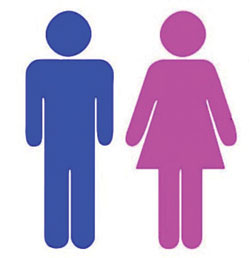It has often been said that sugar, spice, and everything nice is the common formula required to create the perfect girl. Often executed in the form of pigtails, glitter, and all things pink, girls are also expected to follow a special social set of rules, simply labeled “girl code”; the laws which have served as the inspiration behind several online blogs, publications and now a brand new television show on MTV called “Girl Code.”
In a recent article published in the Journal of Personality and Social Psychology, Bobbi Carothers and Harry Reis created a test in order to see whether men and women should be set in separate interest categories. The results showed that college men and women do, in fact, often have different hobbies. Activities such as boxing, construction, playing golf, playing videogames and watching pornography were more interesting to guys. In contrast, taking a bath, talking on the phone, scrapbooking, watching talk shows, and cosmetics were more interesting to girls.
It would appear then that the laws, and the several stereotypes that accompany them, have gained a mass following and power status amongst the female populous. So much media attention aids in furthering the two sexes, especially in the cases of relationship expectations, the notable difference in sports interests, and, of course, where and how their money is spent.
1.) Relationships and Icebergs
Usually women are the ones branded as overly emotional in relationships and come off as expecting too much from their significant others, whereas men are the calmer type with the lackadaisical attitude about most matters which often cause alarm in women.
To top off the emotional turmoil that accompanies a women’s perception of relationships, there are the added girl’s code guidelines such as never dating a friend’s ex. He can possibly have female friends, but not too many if he knows what’s good for him. And god help him if he texts a girl later than he is texting you.
If everything falls well within the code, then there should be smooth sailing along the seas of love. As Melissa Buchanico, a sophomore criminal justice student, can contest, “I think relationships are wonderful, I’m in a relationship now and I have been for 21 months now. I think my boyfriend is great and I’m extremely grateful I have him.”
However great a relationship is though, one can’t help but wonder about the stereotypes involved within the inner workings of it all. Lisa Dinella, assistant professor of psychology, stated that women are often perceived as more nurturing and should be caretakers, emotionally and physically. Though this explains their stereotypical positioning within the relationship, there could be some negative connotations that arise from these preconceived notions within the girl’s professional life.
“My research on this area with my colleagues Drs. Erica Weisgram and Megan Fulcher, show that the more men and women identify with the stereotypes about how men and women should act, the more they express interest in stereotyped careers,” Dinella said. “Our research also shows that women being socialized to place more emphasis on ‘nurturing’ leads them to seek careers that allow them (not men) to have flexible schedules to care for their household, children, and family overall. These types of careers have lower pay. There is nothing wrong with wanting this type of a career— but that men are not socialized with the same values leads them to be the breadwinners—and thus women are often more financially dependent on their husbands.”
2.) Sports Let Me Wear My Cute Little Jerseys
When the topic of sports is tossed into the ring, the statement that women are from Venus and men are from Mars becomes prevalent- or so it is thought. Men are supposed to be the ones drinking all of the beer, spitting expletives at the opposing team or those ‘stupid stinking referees’, and belching. Women are supposed to sit cross legged, serve their guests, and laugh merrily instead. This is what the girl code further reinforces through its stereotypes.
In this turn of the century ideal-gender crossing age, the traditional boundaries are being trespassed by new wave thinking by girls and guys alike. It is not uncommon to find a girl wearing an oversized jersey, lounging on the couch eating wings while rooting for their team like one of the guys.
Take for instance freshman Olivia McDaniel, a psychology major. McDaniel grew up with two sisters and a brother, yet while her sisters would play dress up and paint their nails, she found herself playing soccer and relating more with her brother. “I love to watch sports, especially football and hockey,” McDaniel said. “It just comes more interesting to me than sitting there and fussing over an outfit I’m just going to take off at the end of the day. I’d rather yell at a TV than do that [girly] kind of stuff anytime.”
According to Janice Stapley, an associate professor of psychology, the term ‘mesearch’ is used to describe the type of girls who are, essentially, tomboyish in nature. Having personal, firsthand experience with this mindset, Stapley sees that these stereotypes and girl codes are being broken more and more as the generations go on. “My grandmother loved football, and if you had given her a choice she would have picked watching a football game over going shopping in a nanosecond,” Stapley said.
It is because of these crosses in the barriers that left Stapley with the notion that a lot of the recent gender dialogue is not necessarily masculine vs. feminine anymore, but instead is much more androgynous.
3.) Don’t Need It, But I’ll Buy It
And then there was the ever popular topic of shopping. It is no secret that advertisements and the media play off of the woman shopaholic stint more than they do any other stereotype; primarily because it is so easy to sell a product for any sport, relationship improvement advice, or for any insecurity for that matter.
The tale goes that if any girl thinks she looks fat, she will buy clothes to hide her body, and then when she feels she looks good she will purchase food to celebrate-and dare anyone to tell her otherwise that the process doesn’t make sense. That’s just the way girls are “supposed” to work. Well that’s wrong. Stapley herself stated that in regards to shopping she, “would rather have a gun to her head.”
Sophomore Alex Giorggio, an English major, stated that his love for shopping rivals most females that he knows. “Most girls I know don’t really even want to get up or get dressed to go out and buy a new outfit. I think right there shows that shopping isn’t just strictly set for girls, guys can enjoy it too- maybe even a little more,” Giorggio said.
It would appear that the girl code isn’t something as concrete as initially thought. The stereotypes that the codes rely on are being shattered every day. The Carothers and Reis article found there was no evidence suggesting that men and women should be lumped into discrete categories, or following gender specific codes; especially in areas concerning sexuality, friendships, gender related dispositions and intimacy.
However, Stapley disagrees on the basis that today’s culture puts too much emphasis on gender. “I’ve been watching my children’s twenty-something [year old] friends start having children and they stereotype before the kids are even born,” Stapley said. “I think we stereotype more than we did even thirty years ago.”
No matter how one might see it, whether the stereotypes are coming down quickly or being built up higher than before, it would appear that the code originally thought to be a basis for girls of all ages is evolving along with the idea of gender itself. Perhaps that is a good thing, or maybe not, but whatever the fact may be, something is underway within the psychological makeup for the female; hopefully one that will prove positive instead of a femme fetal.




